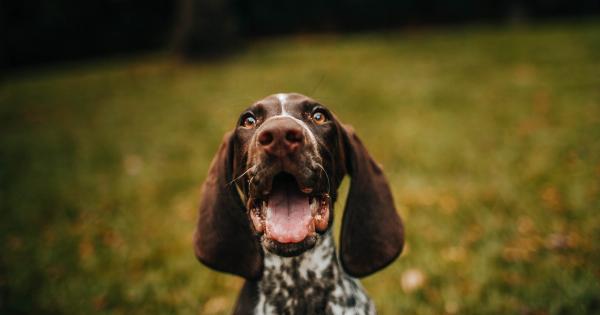Just like humans, dogs can also have bad breath. While it may not be pleasant to be around a dog with stinky breath, it’s important to remember that bad breath can be a sign of underlying health issues.
Therefore, it’s crucial to address the problem and find ways to freshen up your furry friend’s breath. In this article, we will provide you with simple yet effective tips to get rid of your dog’s bad breath.
1. Regular Brushing
One of the easiest and most effective ways to combat bad breath in dogs is regular brushing. Many pet owners overlook brushing their dogs’ teeth, assuming that it’s not necessary or simply forgetting about it.
However, brushing your dog’s teeth at least two to three times a week can make a significant difference in their breath.
Make sure to use a dog-friendly toothbrush and toothpaste. Avoid using human toothpaste as it may contain harmful ingredients for dogs.
Gently brush your dog’s teeth in circular motions, paying extra attention to the gum line where plaque and tartar tend to accumulate.
2. Dental Chews and Toys
Dental chews and toys can be a fun and effective way to improve your dog’s breath. Chew toys that are specifically designed for promoting dental health can help remove plaque and tartar buildup, reducing the chances of bad breath.
Look for dental chews that have a texture or shape that can clean your dog’s teeth as they chew. Additionally, dental toys that dispense treats or have teeth-cleaning bristles can provide extra benefits.
3. Healthy Diet
Just like a human’s diet can affect their breath, a dog’s diet can also play a role in their breath odor. Feeding your dog a healthy and balanced diet can keep their overall oral health in check.
Choose high-quality dog food that is suitable for your dog’s specific breed, age, and size. Avoid feeding them table scraps or unhealthy treats, as these can contribute to bad breath and oral health issues.
Additionally, make sure your dog has access to clean and fresh water at all times.
4. Regular Veterinary Check-ups
Regular veterinary check-ups are essential for your dog’s overall health, including their oral health.
A veterinarian can thoroughly examine your dog’s teeth and gums, identifying any dental issues or underlying health conditions that may contribute to bad breath.
During these check-ups, your vet may recommend professional dental cleanings to remove stubborn plaque and tartar. They may also provide you with specific instructions and tips on how to maintain your dog’s oral health at home.
5. Fresh Breath Treats and Additives
If you’re looking for a quick and convenient solution to your dog’s bad breath, fresh breath treats and additives can help temporarily freshen their breath.
These products are typically formulated with ingredients that can neutralize odor-causing bacteria in your dog’s mouth.
However, it’s important to note that these treats and additives are not a substitute for proper dental care. They should be used in conjunction with other oral hygiene practices for optimal results.
6. Regular Teeth Cleaning
In addition to regular brushing, dogs can benefit from regular teeth cleanings. While brushing can remove plaque and tartar from the surface of their teeth, professional cleanings can address more advanced dental issues.
Consult with your veterinarian about the recommended frequency of professional teeth cleanings for your dog. These cleanings typically involve scaling and polishing, which can significantly improve your dog’s breath and overall oral health.
7. Monitor Dental Health
It’s important to monitor your dog’s dental health on an ongoing basis. This includes observing their behavior during mealtime, checking for any signs of discomfort or pain, and inspecting their teeth and gums regularly.
If you notice any redness, swelling, bleeding, or other abnormalities, contact your veterinarian promptly. Early detection and intervention can prevent dental issues from worsening and causing persistent bad breath.
8. Fresh Water and Hydration
Similar to humans, dehydration can contribute to bad breath in dogs. Always ensure that your dog has access to fresh and clean water throughout the day.
Proper hydration can help maintain saliva production and wash away food particles and bacteria that can cause bad breath.
During hot weather or intense physical activity, provide your dog with extra water and monitor their hydration levels. Additionally, try to avoid letting your dog drink from stagnant water sources, as these can contain bacteria that promote bad breath.
9. Natural Breath Fresheners
Several natural ingredients can freshen your dog’s breath. Parsley is known for its breath-freshening properties and can be added to your dog’s meal in small amounts.
Cinnamon is another natural ingredient that can help combat bad breath in dogs.
However, it’s crucial to talk to your veterinarian before introducing any new ingredients into your dog’s diet. Not all natural products are safe for dogs, and your vet can provide guidance on appropriate quantities and potential risks.
10. Be Consistent and Patient
Lastly, be consistent in your approach to maintaining your dog’s oral health. Incorporate regular brushing into your routine, provide them with dental chews or toys, and monitor their dental health regularly.
Addressing bad breath in dogs may take time and patience. It’s important to remember that persistence is key, and the long-term benefits of fresh breath and optimal oral health are well worth the effort.
In Conclusion
By implementing these simple tips, you can help improve your dog’s breath and ensure their overall oral health. Regular brushing, dental chews, a healthy diet, and proper hydration are just some of the ways to combat bad breath in dogs.
Remember to consult with your veterinarian for personalized advice and recommendations based on your dog’s specific needs. Together, you can keep your furry friend’s breath fresh and their oral health in check.






























